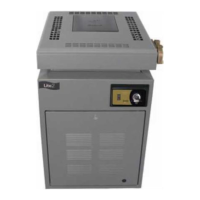Page 10
draft hood. The draft hood must be installed without
modification.
All vent installations must be made in accordance
with all local, state or provincial codes and with:
1. Chapter covering, " Venting of Equipment" of
the National Fuel Gas Code, ANSI 223.1 latest
edition, or the applicable provisions of the local
building codes.
2. In Canada, CAN/CSA-B149.1.
Avoid long horizontal runs of the vent pipe, and
90° elbows, reductions and restrictions. Horizontal runs
should have at least a 1/4 inch rise per foot (20mm
per meter) in the direction of flow.
Avoid terminating heater vents near air condition-
ing or air supply fans. The fans can pick up exhaust
flue products from the heater and return them inside
the building, creating a possible health hazard.
Do not locate the vent terminal where flue
products could strike against building materials and
cause degradation.
Vent opening should be well away from trees or
other obstructions that would prevent free air flow to
and from vent terminal. Do not terminate the vent
under decks, stairways, or car ports.
Be sure to support all venting so that connections
will not separate and so that the weight of the vent
pipe does not rest on the heater draft hood. All con-
nections should be made with rustproof sheet metal
screws. Do not weld or fasten the vent pipe to the
heater draft hood. The draft hood and heater top must
be easily removable for normal heater service and
inspection.
The draft hood outlet is to be connected to an
unobstructed vent pipe of the same diameter, terminat-
ing outside the building. The vent must terminate at
least two (2) feet (0.6 m) above the highest point of
the roof or other object that is within ten (10) feet (3.0
m) of the vent termination. The vent pipe must have a
listed vent cap which allows a full equivalent opening
for flue products (see Figure 5). The top of the vent
cap must be at least five feet in vertical height above
the draft hood outlet.
Type “B” double wall or equivalent vent pipe is
recommended. However, single wall metal vent pipe
may be used as specified in the latest edition of the
National Fuel Gas Code ANSI Z223.1 or in Canada
CAN/CSA-B149.1
IMPORTANT NOTE: Do not use sheet metal
screws at the snap lock joints of Type B gas
vents.
When venting multiple appliances through one
common duct, each appliance must have it’s own
exhaust vent temperature limit switch. All vent
temperature limit switches must be wired in series so
as to prevent all appliances from firing in the event
that any vent opening becomes blocked. Refer to
ANSI Z223.1 in the United states or CAN/CSA-
B149.1 for more information on multiple venting.
3.2.3 Inspection and Replacement of
Existing Vent Systems with New
Components
If the Lite2 is being installed to replace an
existing pool heater, it is recommended that a new
appropriate venting system be installed with the new
heater. However, if an existing venting system must
be used, be sure to carefully inspect the venting
system to ensure that it is in good condition and
continues to be appropriate for the Lite2 heater.
Replace any parts that are not in good and serviceable
condition with new parts before completing the pool
heater installation.
SECTION 4.
Gas Connections
4.1 Gas Supply and Piping
Review the following general instructions before
continuing the installation.
WARNING
The Jandy Lite2 model LJ pool and spa heaters
are designed for use with either natural gas or
LP gas. Check the rating plate on the inner
panel to be sure that the heater is designed to
use the type of gas being supplied. DO NOT
ATTEMPT TO CONVERT THIS HEATER
FOR USE WITH ANY OTHER TYPE OF
FUEL.
AVERTISSEMENT
Les appareils de chauffage Jandy Lite2 modèle
LJ pour piscines et cuves thermales sont
conçus pour être utilisés avec du gaz naturel
ou du gaz de pétrole liquéfié (GPL). Vérifiez
l’information inscrite sur la plaque signalétique
du panneau intérieur pour vous assurer que
l’appareil est conçu pour le type de gaz fourni.
NE PAS ESSAYER DE CONVERTIR CET
APPAREIL À UN AUTRE TYPE DE GAZ.
1. Gas piping installation must be in accordance
with the latest edition of ANSI Z223.1 and all
local codes. In Canada, the installation must be in
accordance with CAN/CSA-B149.1 and all local
codes that apply.
2. Check the gas supply to be sure that it is the
same as the gas indicated on the heater’s rating

